PDS & One Nation, One Ration Card Scheme
2021 JUL 1
Mains >
Agriculture > Storage, transport & marketing > Public distribution system
IN NEWS:
- The Supreme Court has directed all states and Union Territories to implement the One Nation, One Ration Card (ONORC) system.
PUBLIC DISTRIBUTION SYSTEM IN INDIA:
History:
- India’s food subsidy programme is one of the largest safety nets in the world, providing food for nearly 800 million people.
- Public rationing system was first introduced in India during World War II as a temporary relief measure.
- It was expanded in 1960s as a response to the food shortages of the time. It was during this period that the Agriculture Prices Commission and the Food Corporation of India were established.
- Till 1992, PDS was a general entitlement scheme for all consumers without any specific target. Then the Revamped PDS (RPDS) was introduced with focus on the poor families, especially in the far-flung, hilly, remote and inaccessible areas.
- In 1997, the Targeted Public Distribution System (TPDS) was launched, with a focus on the poor. The beneficiaries were divided into two categories:
- Households below the poverty line (BPL)
- Households above the poverty line (APL)
- In 2013, the National Food Security Act, 2013 (NFSA) was enacted which gives legal entitlement to 67% of the population (75% in rural areas and 50% in urban areas) to receive subsidized food grains:
- Rice at Rs 3/kg
- Wheat at Rs 2/kg
- Coarse grains at Re 1/kg
Structure of PDS:
- Central and State Governments share the responsibilities of the PDS system, with the Ministry of Consumer Affairs, Food, and Public Distribution as the nodal ministry.
- The center procures food grains from farmers at Minimum Support Price (MSP) and sells it to states at Central Issue Prices (CIP). It is also responsible for transporting the food grains to the state godowns.
- States transport the food grains from these godowns to fair price shops (ration shop), where the beneficiary buys the food grains at CIP. Many states further subsidize the price before selling it to beneficiaries.
- In the present system, a ration cardholder can buy food grains only from a fair price shop that has been assigned to her in the locality in which she lives.
- As on 28 June 2021, there are about 5.46 lakh fair price shops and 23.63 crore ration card holders across the country.

ONE NATION, ONE RATION CARD:
- 'One Nation One Ration Card' is a scheme implemented by the government providing for nation-wide portability of National Food Security Act benefits.
- Even though the ONORC was officially launched in August 2019, work on ration card portability had begun in April 2018 when the IM-PDS was launched.
- ONORC was initially launched as an inter-state pilot scheme. However, due to the distress from Covid-19 pandemic, the government announced its national roll-out as a part of the economic relief reforms in March 2021.

- Objective:
- The scheme seeks to provide portability of food security benefits, i.e. a beneficiary will be able to buy subsidized food grains from any fair price shop across the country.
- Methodology:
- Beneficiaries can purchase the quantity of food grains they are entitled to under the NFSA. However, for availing the benefits, linking of ration cards with their Aadhaar card is mandatory.
- An Integrated Management of PDS (IM-PDS) portal provides the technological platform for inter-state portability of ration cards, while Annavitran portal provides intra state portability (i.e inter and intra district).
- Biometric authentication and electronic Point of Sale (ePoS) devices installed at the Fair price shops will be used to identify the beneficiaries.
- Enrolment:
- The Centre has designed a standard format for ration cards: a standard bilingual format with a 10-digit ration card number.
- The beneficiaries are enrolled by the state government. Centre has asked state governments to follow the pattern while issuing fresh ration cards.
- Coverage:
- Till date, 32 states and Union Territories have joined the ONORC, covering about 69 crore NFSA beneficiaries. Four states are yet to join the scheme — Assam, Chhattisgarh, Delhi and West Bengal.
Note: Incentivization from Central government
- The Centre had set the implementation of ONORC as a precondition for additional borrowing by states during the Covid-19 pandemic last year. At least 17 states, which implemented the ONORC reform, were allowed to borrow an additional Rs 37,600 crores in 2020-21.
|
WORKING:
- Consider for example Ms. ABC, a ration-card holder, who hails from Madhya Pradesh, but is presently employed in Rajasthan. Owing to the ONORC scheme, A can accrue PDS benefits from a fair-price shop in Rajasthan or in any other part of the country where ONORC is implemented.
- When A visits an FPS, they load their biometric details on ePoS, which is matched with their details on the Annavitran portal, thereby identifying A as a legitimate beneficiary. Once the authentication has been completed, the dealer can give A what she is entitled to. At the same time, A’s family members, who may still be living in Madhya Pradesh, can continue to buy their share of food grains from an FPS back home.
|
SIGNIFICANCE:
- Universality of PDS:
- The Economic Survey of India 2017 estimated that inter-state migration in India was close to 9 million annually between 2011 and 2016. Most of these migrant labourers are employed in the informal sectors, making it difficult for welfare delivery. The introduction of ONORC system will provide universal access to PDS food grains for the beneficiaries anywhere within the country.
- Portability of social security:
- Through this scheme, one can buy their share of entitled food grains from wherever they are based, while the rest of their family members can purchase grains from their ration dealer back home. This mechanism allows for the mobility of social security net provided by the PDS system.
- Achieve hunger-free India:
- In the 2020 Global Hunger Index published by Concern Worldwide and Welthungerhilfe, India ranks 94th out of 107 countries. The ONORC scheme will help address this poor state of hunger in India. It will also help achieve the target set under SDG 2: Ending hunger by 2030.
- Reduce leakages:
- Digitization of the process through Aadhaar-linked ration cards and smart cards can eliminate ineligible, bogus and duplicate beneficiaries and reduce diversion of food grains.
- Empowers consumers:
- ONORC will give the beneficiaries the opportunity to opt for the dealer of their choice, without the troubles of lengthy paperwork. This also makes the dealers more responsible, as now they have to fear the loss of customers.
- Planned development and migration policies:
- The centralized data repository is useful in identifying the trends in migration in India. It will give a better picture of the major sources and destinations of migrations, as well as the temporal variations in migrations. This can be useful in developing policies for planned urban development and management of migration in India.
- Better targeting:
- Since the beneficiary identifier is linked to the Aadhar database, by slicing and dicing of the data through technologies like artificial intelligence, it is feasible to create more customized and targeted welfare measures.
- Eg: The ONORC database can be used by state governments to provide relief to migrants during crisis such as calamities and pandemics.
CHALLENGES:
- Inter-state issues:
- Every state has its own rules and subsidy schemes for the Public Distribution System. States like Tamil Nadu and Chhattisgarh run a universal or near-universal PDS. But the introduction of ONORC scheme will disrupt these systems.
- Also, due to subsidies provided over and above CIP, states have different rates for the grains and this non-uniformity in price will be a challenge.
- Logistics:
- The centre allocates food grains to states on the basis of their BPL population, the availability of stocks and the quantity of food grains lifted by states for distribution under TPDS. Subsequently, the FPSs receives monthly quota based on the number of people assigned to it.
- However, the ONORC could disrupt this, as some states and FPSs may have to cater to more numbers of cards while others cater to less.
- Data deficiency:
- The success of the system relies on data available with governments regarding migrant populations and various trends in migration. However, neither the central nor the state governments have such exact data on migrant population.
- Technological barriers:
- IT-enabled services are crucial for the functioning of the scheme. However, there are issues related to 100% digitization of ration cards, availability of PoS machines, reliable internet connectivity, issues related to biometrics etc.
- Eg: Chhattisgarh is yet to implement the scheme as it is reportedly still gathering enough POS machines.
- Shortage of storage facilities:
- Open ended procurement of grains has already resulted in the FCI holding on to more grain stocks than it can store. Also, there are stark regional differences in the availability of storage facilities within India.
- However, implementing ONORC without augmenting the storage capacities will only exacerbate the issues of poor quality and loss of food grains.
- Ignores dietary choices:
- Food choices in India are diverse. A migrant from North India working in south India may prefer wheat over rice. However, such preferences are not considered in the present system. Also, rice and wheat continue to be the focal point of PDS, while nutri-cereals and local products remain ignored.
- Inclusion/exclusion errors:
- The imposition of Aadhaar in the existing PDS has created problems of exclusion and higher transaction costs for the poor. With the ONORC system, there is fear that more beneficiaries will be left out of the system.
- Lack of awareness:
- Till date, 32 states and Union Territories have joined the ONORC, covering about 69 crore NFSA beneficiaries. However, the number of inter-state transactions is much lower than that of intra-district and inter-district transactions. This indicates a lack of awareness among the migrant population regarding the scheme and facilities.
- Social challenge:
- Since the scheme favours migration, it may aggravate regionalism and ‘sons-of-soil’ movements in the country. Areas having xenophobia may also experience resistance towards serving a migrant.
WAY FORWARD:
- Documentation:
- There is an urgent need to collect data on the migrants, which thoroughly covers their socio-economic backgrounds. States should collaborate among themselves to precisely map the migration networks, studying, recording and regularly updating labour migration patterns.
- All India coverage:
- In order to realize the full benefit of the scheme, the remaining 4 parties- Assam, Chhattisgarh, Delhi and West Bengal - should also be brough under the scheme. To achieve this, central and state governments should undertake proactive efforts.
- Augment storage and allocation facilities:
- FCI godowns should be supplemented by other storage facilities. For this, measures such as the Grameen Bhandaran yojana and PPP models should be utilised.
- The allocation of the food grains to states should be dynamic, based on real time data and use of credible demand forecasting systems.
- Move towards choice-based PDS:
- Experts have noted that TPDS could be replaced with choice-based PDS, such as in the form of cash transfers or food coupons. This will empower the people to choose the food they desire.
- Adopt successful practices:
- For better results, innovative and novel measures can be incorporated in the ONORC scheme.
- For eg: Social auditing can be made mandatory for the scheme so as to ensure its efficiency.
- Expand portability of more schemes:
- Carrying the momentum forward, other social security measures such as Integrated Child Development Services, Mid-Day Meals, immunisation, health care and other facilities should also be made portable.
PRACTICE QUESTION:
Q. Critically examine the role of One-Nation, One-Ration Card system in transforming the Public distribution system of India?
